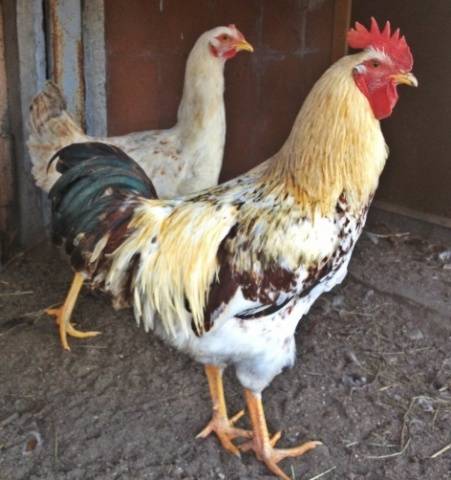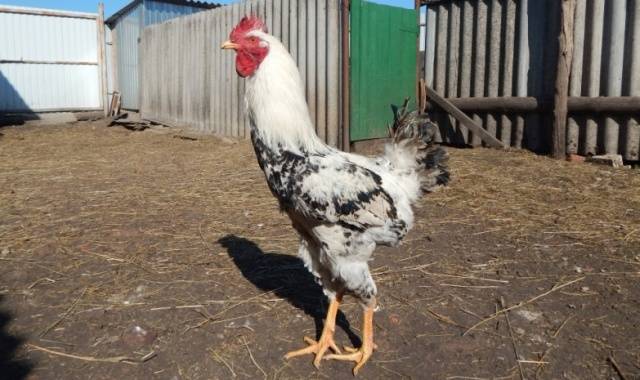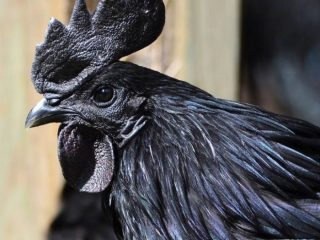Content
The love of the Russian people for the morning rooster crow led to the emergence of a breed of chickens, the main task of which was not to provide the owners with eggs or meat, but beautiful rooster crow. The Yurlovsky vocal breed of chickens appeared thanks to “folk selection”, when roosters were selected for the beauty of their singing, without paying much attention to appearance. The stories that Count Orlov-Chesmensky was a multi-plant breeder and, in addition to horses, bred two more breeds of chickens: Orlovskaya and Yurlovskaya, do not have documentary evidence.
A more plausible version says that the Yurlovskaya chicken breed appeared near the city of Livny, which is located almost on the southern border of the Oryol region. Previously, not far from Liven there was the now defunct village of Yurlovo, from which the chickens took their name.
Origin and description
The exact origin of the breed is unknown. It is precisely established that it is not related to other “song” chickens. It is believed that the Yurlov breed of chickens appeared as a result of crossing Chinese meat chickens and Asian fighting birds with local “village” laying hens. Subsequently, selection of roosters was based on singing qualities.Moreover, the standard beginning of a rooster's crow was considered undesirable, and the rooster had to crow as long as possible.
Good singing is impossible without a certain body structure, therefore, in parallel with the selection for voice, the formation of the exterior of the Yurlovsky vocalists took place. Even in the absence of breeding knowledge, cock crow enthusiasts unwittingly selected for a certain type of rooster. Today, Yurlov chickens are relatively few in number, and lovers of this breed select not only for singing, but also for appearance.
This is due to the fact that unscrupulous breeders these days are adding the Turkish breed of Denizli chickens to the Yurlovsky vocal ones.
Standard
In the absence of official directions of “fighting” and “singing” in modern chicken breeding, the Yurlov breed is classified as a meat-egg type. This is a fairly large chicken, but there is a significant variation in live weight in the population:
- adult chickens 3-3.5 kg;
- in adult roosters the range is greater: 3.5-5.5 kg.
In roosters, this difference is associated precisely with selection for singing, and not for productive characteristics.
Outwardly, adult roosters give the impression of a very powerful large bird. A mature male is exactly like this, as can be clearly seen from the photo of the rooster of the Yurlov breed of chickens.
Exterior requirements for a rooster
Large head with a round nape. The beak is powerful, curved and strong. Depending on the color of a particular bird, the beak can be dark bronze, black or yellow. There is a fold on the lower half of the beak. The color also affects the color of the eyes: red, brown or red.Healthy chickens should have clean and shiny eyes. The brow ridges are large.
The comb can be of almost any shape: leaf-shaped, rose-shaped, nut-shaped or pod-shaped. The pod-shaped and leaf-shaped ridges should clearly follow the line of the back of the head, without lifting up. With a leaf-shaped comb, the comb should have 7 teeth, and its height should not exceed 4 cm.
The earrings are medium in size, oval in shape, with a smooth surface. Bright red, small lobes. The face is unfeathered and red.
The neck is long, set vertically. The angle between the body and neck is 90°. The body is powerful, very wide, slightly tapering towards the tail. When viewed from the side it appears triangular. The back and lower back are very wide and straight.
This expression means that the back and lower back are not only flat and very wide, but also located horizontally in relation to the ground, as can be clearly seen below in the photo of the rooster of the Yurlovsky vocal breed of chickens. The tail and neck outline the other two sides of the upper "rectangle". In roosters, a more vertical position of the body is desirable, so their body usually drops slightly towards the tail.
The chest is well developed and wide. A large chest girth provides plenty of room for the lungs, one of the important factors for long-lasting singing.
Shoulders are broad and powerful. The wings are well developed, fit tightly to the body, and are of medium size.
The tail is small and bushy. Placed at an angle of 90° to the lower back. The plumage in the tail is tightly compressed. Well developed, clearly defined belly. The lower legs are powerful, long, with dense plumage.The length of the legs is sufficient for them to be visible from under the cover feather on the body.
The metatarsals are very long, their length from the sole to the tibia is 15-18 cm. The metatarsal bone is thick. The color of the metatarsals is also directly dependent on the color and, like the beak, can be dark bronze, black or yellow. The claws are either black or light yellow. The sole is light.
The plumage is loose and can be of almost any color. Yurlovsky vocal cats have never been selected for their color. There are 5 common colors:
- black;
- golden-black;
- matte black;
- Colombian;
- salmon.
But other colors are also possible. Often you come across speckled individuals that cannot be matched to any of the five types of colors.
This situation arises due to the fact that the multi-colored lines are not drawn cleanly.
Chicken standard
The requirements for the Yurlovsky vocal laying hen are almost no different from the requirements for a rooster. The only differences are in the size of the comb, lobes and earrings, which are smaller in a chicken than in a rooster. The length of the metatarsus also differs. It is 3 cm shorter. The length of the chicken's metatarsus is 12-15 cm.
Laying hens are late maturing. They begin laying their first clutch only at 6 months. The egg production of the Yurlov Vociferous is average for a meat-egg breed: 130-160 pieces per year. According to reviews from owners of the Yurlov breed of chickens, individual laying hens can produce up to 200 very large eggs per year. The owners of laying hens claim that each egg can weigh up to 90 g. However, they do not specify how many yolks are in such eggs. The shells of Yurlovsky vociferous eggs are creamy.
Exterior Disadvantages
Disadvantages differ from defects in that, under certain conditions, a chicken with defects can be bred.For example, if the number of breeding stock is small, the hen is allowed into breeding, selecting the “ideal” rooster for her. Birds with defects under any circumstances are sent only to soup.
Disadvantages of the Yurlovsky vocal breed of chickens:
- small brow ridges;
- white plaque on the earlobes;
- lack of folds on the lower part of the beak;
- long earrings;
- flesh-colored or bluish-gray color of the metatarsals and toes;
- clearly horizontal body posture of the rooster;
- a chicken's comb tilted to one side.
Typically, females are “forgiven” more shortcomings than males, since one rooster per ten hens is enough for breeding. Roosters are subject to more stringent requirements. A male with shortcomings goes into breeding in a completely hopeless situation.
Exterior defects
If such signs are present, Yurlovskaya vociferous definitely goes to the soup:
- processes on the ridge;
- the height of the leaf-shaped ridge is over 4 cm;
- the rooster's comb falls to one side;
- the comb does not fit tightly to the back of the rooster's head, but is raised above it;
- the tail is turned in relation to the body;
- crooked;
- squirrel;
- feathered metatarsals;
- feathered face;
- crest on the head;
- short legs;
- shortened neck;
- shortened and narrow body;
- lack of a well-developed keel.
An undeveloped keel reduces the depth of the chest, reducing the rooster's ability to sing continuously.In the sources you can usually find only a description of the defects of the Yurlov breed of chickens without photos, so it is quite difficult to get an idea of what this or that type of defect is.
What a “feathered metatarsus” is is usually clear to poultry farmers without explanation. Chinese meat breeds, which are among the ancestors of Yurlov chickens, are characterized by this trait and sometimes it appears in modern individuals.
A raised ridge is quite common.
A poorly developed keel is sometimes difficult to notice without touching the bird. But often the body shape of a “keelless” rooster resembles that of a duck.
In the video, the breeder of the Yurlovsky vocal breed of chickens explains in detail what this bird should be like and how to select roosters for the breed.
Development of young animals
The survival rate of adult birds is relatively low, only 77%. At the same time, the safety of young animals up to 17 weeks is 96%.
Often the owner’s description of the young Yurlovsky vocal breed of chickens sounds like “they look like ostriches.”
Some roosters, with a larger and more developed body, really resemble ostriches. But most look like the bird-like dinosaur Ornithomiumus. Moreover, chickens “don’t go out of character” even in adulthood.
Pros of the breed
Adaptation to Russian climatic conditions and preservation of the brooding instinct in some hens. Thanks to the latter quality, some Yurlovka vociferous chickens can be used as brood hens.
How to select a rooster for breeding
Reviews about the Yurlovsky vocal breed of chickens as “long-playing” warblers are true. Although the beauty of the low voices of Yurlov’s roosters is a controversial issue. Rather, such singing is not for everyone.
Yurlov chickens are selected for breeding stock based on several characteristics:
- the duration of singing is at least 8 seconds;
- the lowest possible voice is preferred;
- To obtain “warblers”, chickens with a low, deep clucking sound are selected for the breeding stock.
There are also a couple of signs that a rooster can become a good singer. Usually the most unprepossessing individuals sing well. Future good “singers” start singing very late: after 7 months. Ideally, a rooster should crow when he is one year old.
Reviews
Conclusion
The population of Yurlovsky vocal chickens today numbers less than 7 thousand heads. The breed is bred at breeding stations as genetic material for breeding new crosses. You can find these chickens on private farms and in non-specialized poultry farms.Due to mixing with Turkish Denizli, the original qualities of the breed disappear. So you need to be very careful when choosing a seller if you need a real Yurlovsky vocal breed of chickens.



















